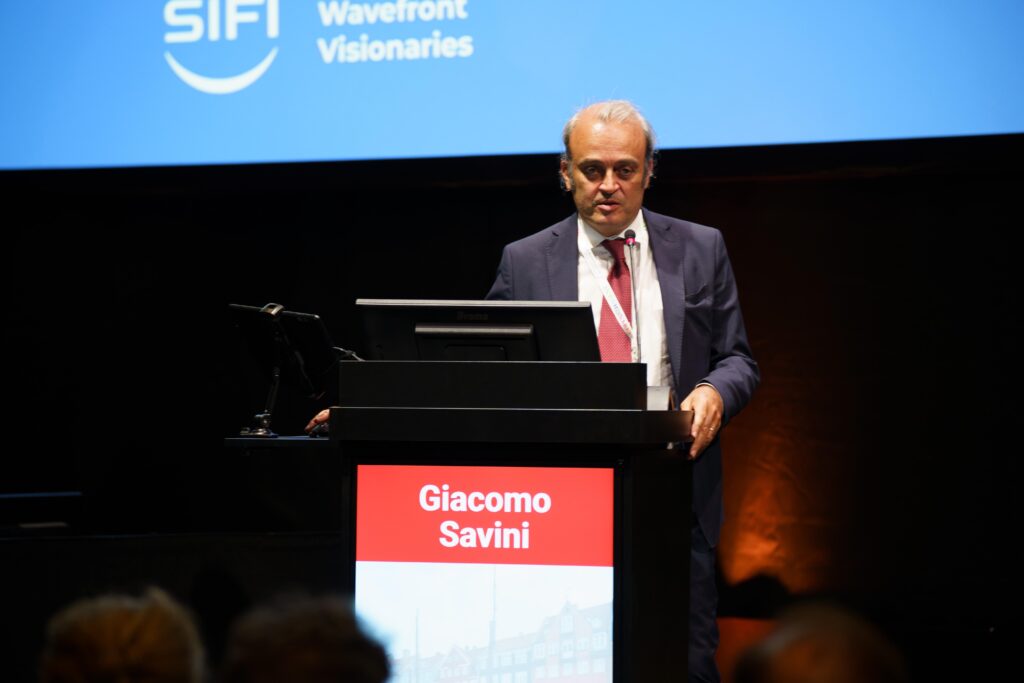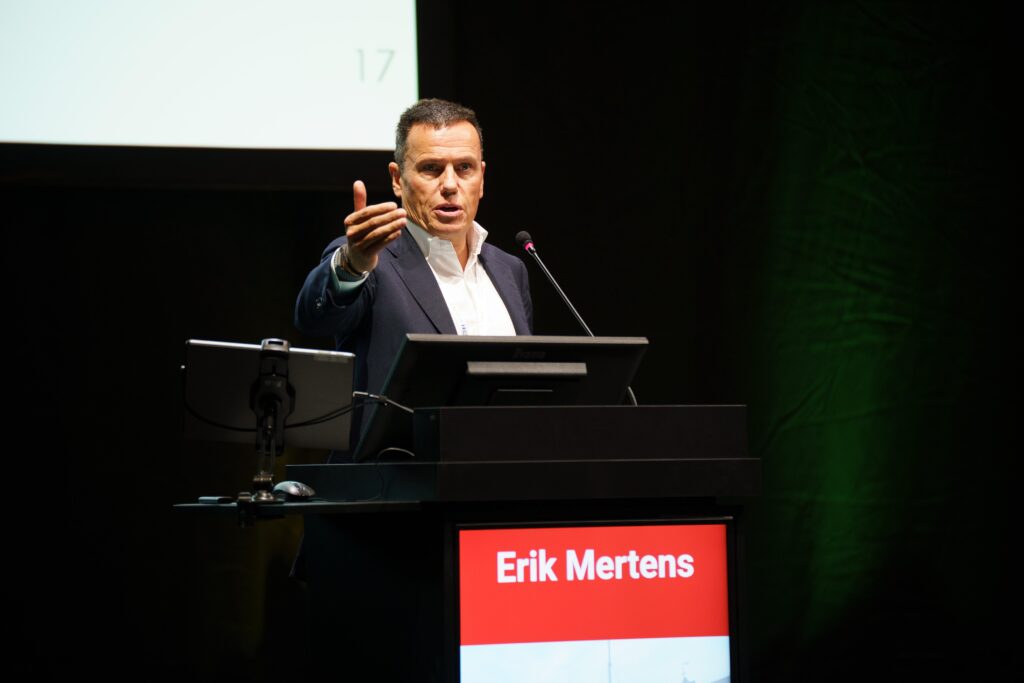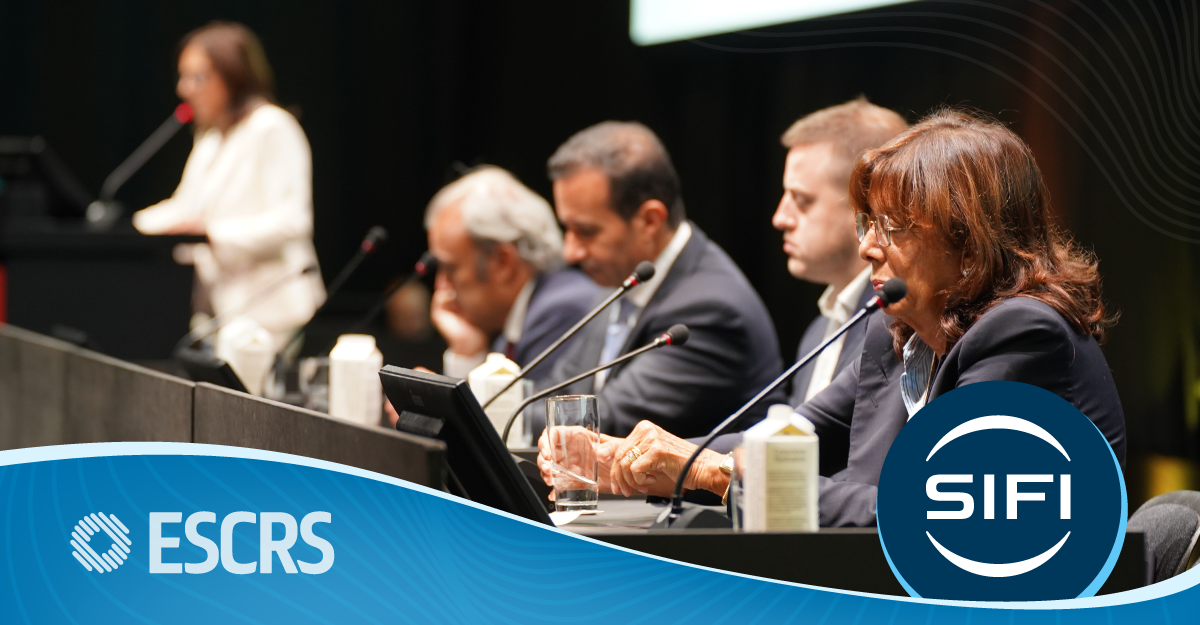Mastering wavefront technology to unlock all the possibilities that stretching light has to offer—a studied and ideal balance between quality and quantity of vision
Sponsored by SIFI
Intraocular lenses (IOLs) never fail to spark discussion among ophthalmologists—and at the 43rd Congress of the European Society of Cataract and Refractive Surgeons (ESCRS 2025), experts gathered to discuss on the SIFI IOLs’ common DNA: the proprietary wavefront technology and its benefits: evidence based, seamless visual outcomes across all distances and uncompromised patient satisfaction.
Decoding SIFI IOL functionalities
With so many IOLs on the market, the ESCRS IOL Functional Classification is an indispensable compass for clinicians searching for the “right” lens for their patients.
Opening with How SIFI IOLs Fit into the Evolving Classification Landscape, Prof. Filomena Ribeiro (Portugal) walked through how SIFI’s lenses fit into this evidence-based system.

She explained that the new functional classification of IOLs has been developed, based on standards-defined end-points, particularly the range of focus (RoF) measured from monofocal defocus curves. Using cluster analysis, the system was qualified as evidence-based and relies on two key metrics: RoF at 0 D defocus, using 0.2 or 0.3 logMAR cut-offs and ΔVA from intermediate to near when VA decline is non-monotonic.
Depending on data collection methods and biometric parameters, an IOL’s place in the classification can shift.
Prof. Ribeiro noted that the SIFI EVOLUX® IOL lands in the “partial depth of field enhanced” category, while the Mini WELL® falls under “partial depth of field extended.” The WELL Fusion® System, meanwhile, is currently considered “full depth of field,” although she pointed out that more evidence is needed before this label can be assigned with high certainty.
Unlike diffractive IOLs, SIFI’s presbyopia-correcting portfolio relies on wavefront technology to provide a smoother, more continuous range of vision with fewer side effects.
Accurate formulas for reliable predictions
Formulas may not excite dinner-party conversation, but in the clinic they make all the difference. Dr. Giacomo Savini (Italy) highlighted the newly updated SIFI IOL Calculator, which employs the fifth-generation, AI-powered Hoffer QST formula for spherical equivalent and the Naeser/Savini toric calculator for cylinder predictions, ensuring maximum accuracy.

The Hoffer QST formula has been shown to be one of the most accurate formulas for IOL power calculation, while the Næser/Savini calculator has been shown to be one of the most precise solutions for toric IOL calculation, proven by several recent published studies.
“We did a short analysis of 36 patients implanted with EVOLUX® and measured with the IOLMaster 700 (ZEISS). Using the values available on the SIFI calculator, we got a mean prediction error of zero,” he said. “This means that the constant is correctly optimized so you don’t have a hyperopic or myopic bias.”
Eighty-nine percent of eyes with a prediction error fell within 0.50 diopters, though Dr. Savini reminded colleagues to warn patients that about 10% of cases may still deliver a refractive surprise of +0.50 D or more.
For toric IOL selection, he added a word of caution: always pay close attention to total corneal astigmatism.
WELL Fusion® for presbyopic cataract patients
The WELL Fusion® System brings together two non-diffractive, true EDoF IOLs—Mini WELL® and Mini WELL PROXA®—and lets them play to their strengths.
Prof. Ahmed Assaf (Egypt) explained that Mini WELL® has three optical zones, designed for continuous vision from distance, to optimal near at 40 cm, while Mini WELL PROXA® has five zones that lean more heavily toward near vision (at 35 cm). This unique optical system grants full range of vision while maintaining an excellent patient satisfaction and visual safety profile (minimal haloes and glare).

“The lenses are not mix-and-match, but rather complementary and work in synergy with each other,” he said. Typically, Mini WELL® is implanted in the dominant eye and Mini WELL PROXA® in the non-dominant one.
In his practice, the second-eye choice is guided by the patient’s feedback after the first surgery. “If the patient is happy with the Mini WELL® we implant the Mini WELL® in the other eye. If the patient expresses more need for reading, then we implant the Mini WELL PROXA® in the other eye.”
Drawing on 100 patient cases, Prof. Assaf reported that distance visual acuity outcomes were similar whether bilateral Mini WELL® or the Fusion® System was used. However, the Fusion® System provided superior intermediate vision at 66 cm and stronger near performance at 35 cm.
“We had good results with the Fusion® System,” he said. “[There’s] additional value with the Mini WELL Fusion® System in terms of near vision, whether uncorrected or corrected.”
Putting EVOLUX® to the test
How does SIFI’s EVOLUX® IOL, with its enhanced range of vision and non-diffractive optical design, stack up against its peers?
Prof. Cinzia Mazzini (Italy) presented results from a prospective study comparing EVOLUX® with the TECNIS Eyhance™ (Johnson & Johnson Vision). Fifty patients were enrolled, with 25 eyes implanted with each lens.

At 12 months, the EVOLUX® group demonstrated better visual acuity (VA) across all distances, as well as reduced need for near and intermediate add. Both groups showed strong refractive and functional stability with no significant posterior capsule opacification, good contrast sensitivity, and no cases of glare or halos.
Prof. Mazzini concluded that “EVOLUX® provides the same distance VA as a monofocal IOL, but with more intermediate vision to improve functional performance in daily life, good contrast sensitivity, less dysphotopsias than diffractive extended depth of focus (EDoF) and other diffractive IOLs, minimum chair time and at a similar price as a monofocal.”
Transforming vision with EVOLUX®
At Svjetlost Eye Clinic (Croatia), Dr. Krešimir Gabrić has overseen more than 600 EVOLUX® implantations. That number alone, he said, reflects confidence in the lens. “IOLs are becoming the new standard of care,” he explained. “They broaden clear vision—especially intermediate—without diffractive optics, so patients experience fewer disturbances.”

A retrospective study of 116 eyes from 82 patients reinforced this view. The results included:
- UDVA improved from 0.89±0.54 logMAR to 0.10±0.14 logMAR (p<0.001).
- UNVA at 40 cm improved from 0.94±0.36 logMAR to 0.47±0.19 logMAR (p<0.001).
- 85% of patients no longer needed spectacles for intermediate work.
- 96% achieved UDVA of at least 20/40.
- 76% landing within ±0.50 D of target refraction.
The monocular defocus curve revealed functional vision of 0.2 logMAR or better across a 2.0 D range, with effective intermediate and near vision, as well as preserved contrast sensitivity and minimal dysphotopsia.
Dr. Gabrić observed that EVOLUX® either matches or surpasses other enhanced monofocal IOLs, citing smooth visual transition, less pupil dependent performance and wavefront optimization as differentiators. Safety and stability were also clear strengths, with tolerance for minor tilt or decentration.
“For cataract patients, EVOLUX® is ideal for excellent distance plus enhanced intermediate vision with minimal photic phenomena,” he said. Refractive lens exchange (RLE) patients, he added, also benefit from reduced spectacle dependence.
EVOLUX® has shown particular value for patients with comorbidities such as glaucoma, mild macular degeneration or epiretinal membrane—and for high-volume surgeons aiming to satisfy increasingly discerning patients.
From optics to outcomes
Dr. Erik Mertens (Belgium) observed that “When talking about the range of vision provided by IOLs, EVOLUX is, in my opinion, even better than an enhanced monofocal, landing in the Increased Range of Vision segment, so mitigating presbyopia correction”, based on AECOS classification.

A memorable case was presented: a 63-year-old taxi driver who works night shifts. His top priorities were crisp night vision, spectacle independence and the ability to see both his dashboard and his credit card reader without difficulty.
Dr. Mertens implanted EVOLUX® with mini-monovision, emphasizing its advantages over other IOLs, including lower dysphotopsia, no dependence on pupil size, a wider depth of focus and a more efficient delivery system.
The outcome ticked every box. The patient experienced no glare or halos under any light condition and reported he could drive, read his dashboard and use GPS without glasses. His verdict was simple: “It feels like when I was 35 to 40-years-old, [I have the] same vision.”
Editor’s Note: Reporting for this story took place at the 43rd Congress of the European Society of Cataract and Refractive Surgery (ESCRS 2025), held from 12-16 September in Copenhagen, Denmark. This content is intended exclusively for healthcare professionals. It is not intended for the general public. Products or therapies discussed may not be registered or approved in all jurisdictions, including Singapore.
